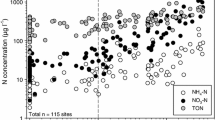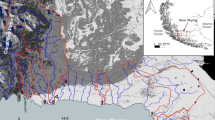Abstract
Data from 13 catchments with no arable land in Northern Scotland were used to develop empirical linear regression models of average monthly NO3 − concentrations and average summer and winter concentrations for NH4 +, dissolved organic N (DON) and dissolved organic carbon (DOC) as a function of catchment characteristics. All catchments displayed a pronounced seasonal NO3 − cycle. Variation in monthly mean NO3 − concentration within and between catchments could be predicted from mean monthly air temperature using separate regression equations for temperatures < and ≥ 5 °C. Soil type, climate and land use influenced NH4 + concentrations. In summer, concentrations of NH4 + were largest in catchments with extensive areas of brown forest soils, which are less acidic and more base-rich than other upland soils. However, concentrations declined with increasing conifer cover and summer rainfall. In winter, however, % conifer cover had a positive effect, while higher temperature and higher humus iron podzol cover had negative influences. DON concentration decreased with increasing catchment elevation in both summer and winter. Surprisingly, concentrations of DON only displayed a positive relationship with percentage peat cover in the summer. The most important factor controlling DOC concentration was soil type, with a positive relationship being observed between DOC and peat and humus iron podzol coverage. Elevation was also important, but only in the winter when concentrations were negatively correlated with maximum catchment elevation. Overall, multivariate regression equations explained the spatial and seasonal variability in N species concentrations over a range of catchments within Northern Scotland.
Similar content being viewed by others
References
Aber J.D., Nadelhoffer K.J., Stuedler P. and Melillo J.M. 1989. Nitrogen saturation in northern forest ecosystems. Bioscience 39: 378–386.
Adamson J.K., Scott W.A. and Rowland A.P. 1988. The dynamics of dissolved nitrogen in a blanket peat dominated catchment. Environ. Pollut. 99: 69–77.
Arheimer B., Andersson L. and Lepsito A. 1996. Variation of nitrogen concentration in forest streams-influence of flow, seasonality and catchment characteristics. J. Hydrol. 179: 281–304.
BADC 2000., http://www.badc.rl.ac.uk/.
Black K.E., Lowe J.A., Billett M.F. and Cresser M.S. 1993. Observations on the changes in nitrate concentrations along streams in seven upland moorland catchments in northeast Scotland. Water Res. 27: 1195–1199.
Bringmark L. 1980. Ion leaching through a podzol in a Scots pine stand. In: Structure and Function of Northern Coniferous Forests, an Ecosystem Study. EdPersson T. Ecological Bulletin, SDOCkholm 32: 341–361.
Campbell J.L., Hornbeck J.W., McDowell W.H., Buso D.C., Shanley J.B. and Likens G.E. 2000. Dissolved organic nitrogen budgets for upland, forested ecosystems in New England. Biogeochem 49: 123–142.
Chapman P.J. and Edwards A.C. 1999. The impact of atmospheric nitrogen deposition on the behaviour of nitrogen in surface waters. In: Langan S.J. (ed.), The Impact of Nitrogen Deposition on Natural and Semi-natural Ecosystems. Kluwer Academic Publishers, Dordrecht, pp. 153–212.
Chapman P.J., Edwards A.C., Reynolds B., Cresser M.S. and Neal C. 1998. The nitrogen content of rivers in upland Britain: the significance of organic nitrogen. In: Hydrology, Water Resources and Ecology in Headwaters (Proceedings of the Headwater '98 Conference held at Meran, Italy, April 1998). IAHS Publ., pp. 443–450.
Chapman P.J., Edwards A.C. and Cresser M.S. 2001. The nitrogen composition of streams in upland Scotland: some regional and seasonal differences. Sci. Total Environ. 265: 65–83.
Cresser M.S., Smart R., Billett M.F., Soulsby C., Neal C., Wade A. et al. 2000. Modelling water chemistry for a major Scottish river from catchment attributes. J. Appl. Ecol. 37: 171–184.
Domburg P., Edwards A.C., Sinclair A. and Chalmers N.A. 2000. Assessing nitrogen and phosphorus efficiency at farm and catchment scale using nutrient budgets. J. Sci. Food Ag. 80: 1–7.
Duckworth C.M.S. and Cresser M.S. 1991. Factors influencing nitrogen retention in forest soils. Environ. Pollut. 72: 1–21.
Edwards A.C., Cook Y., Smart R. and Wade A. 2000. Concentrations of nitrogen and phosphorus in streams draining the mixed land-use Dee catchment, north-east Scotland. J. Appl. Ecol. 37, (Suppl. 1): 159–170.
Edwards A.C., Creasey J. and Cresser M.S. 1985. Factors influencing nitrogen inputs and outputs in two Scottish upland catchments. Soil Use Manage 1: 83–87.
Heathwaite A.L., Burt T.P. and Trudgill S.T. 1993. Overview-the nitrate issue. In: Burt T.P., Heathwaite A.L. and Trudgill S.T. (eds), Nitrate: Processes, Patterns and Management. Wiley, Chichester, pp. 3–21.
Howarth R.W., Billen G., Swaney D., Townsend A., Jaworski N., Lajtha K. et al. 1996. Regional nitrogen budgets and riverine N&P fluxes for the drainages to the North Atlantic Ocean: Natural and human influences. Biogeochemistry 35: 75–139.
Jenkins A., Boorman D. and Renshaw M. 1996. The UK Acid Waters Monitoring Network: an assessment of chemistry data, 1983-93. Freshwater Biol. 36: 169–178.
Langan S.J., Wade A.J., Smart R., Edwards A.C., Soulsby C., Billett M.F. et al. 1997. The prediction and management of water quality in a relatively unpolluted major Scottish catchment: current issues and experimental approaches. Sci. Total Environ. 194/195: 419–435.
Lee K.Y., Fisher T.R., Jordan T.E., Correll D.L. and Weller D.E. 2000. Modeling the hydrochemistry of the Choptank River Basin using GWLF and Arc/Info: 1. Model calibration and validation. Biogeochem. 49: 143–173.
MISR 1963. The Soils of the Country around Aberdeen, Inverurie and Fraserburgh. Memoirs of the Soil Survey of Great Britain. Macaulay Institute for Soil Research, HMSO, Edinburgh.
MISR 1984. Macaulay Institute for Soil Research, 1984. Organisation and methods of the 1:250 00 Soil Survey of Scotland. The Macaulay Institute for Soil Research, Aberdeen, UK.
Mitchell M.J., Driscoll C.T., Kahl J.S., Likens G.E., Murdoch P.S. and Pardo L.H. 1996. Climatic control of nitrate loss from forested watersheds in the Northeast United States. Environ. Sci. Tech. 30: 2609–2612.
Monteith D.T., Evans C.D. and Reynolds B. 2000. Are temporal variations in the nitrate content of UK upland freshwaters linked to the North Atlantic Oscillation? Hydrol. Proces. 14: 1745–1749.
Murdoch P.S., Burns D.A. and Lawrence G.B. 1998. Relation of climatic change to the acidification of surface waters by nitrogen deposition. Environ. Sci. Tech. 32: 1642–1647.
MLURI 1993. The Land Cover of Scotland 1988. Macaulay Land Research Institute, Aberdeen.
Qualls R.G. 2000. Comparison of the behaviour of soluble organic and inorganic nutrients in forest soils. Forest Ecol. Manage. 138: 29–50.
Reynolds B., Emmett B.A. and Woods C. 1992. Variations in stream water nitrate concentrations and nitrogen budgets over ten years in a headwater catchment in mid-Wales. J. Hydrol. 136: 155–175.
Reynolds B. and Edwards A.C. 1995. Factors influencing dissolved nitrogen concentrations and loadings in upland streams of the UK. Agricultural Water Management 27: 181–202.
Reynolds B., Ormerod S.J. and Gee A.S. 1994. Spatial patterns in stream nitrate concentrations in upland Wales in relation to forest cover and forest age. Environ. Pollut. 84: 27–33.
Roberts G., Reynolds B. and Talling J. 1989. Upland Management and Water Resources: Report to DOE and the Welsh Office. Institute of Hydrology, Wallingford, UK.
Russell M.A., Walling D.E., Webb B.W. and Bearne R. 1998. The composition of nutrient fluxes from contrasting UK river basins. Hydrol. Processes. 12: 1461–1482.
Scholefield D., Lord E.I., Rodda H.J. and Webb B. 1996. Estimating peak nitrate concentrations from annual nitrate loads. J. Hydrol. 186: 355–373.
Smart R.P., Soulsby C., Neal C., Wade A., Cresser M.S., Billett M.F. et al. 1998. Factors regulating the temporal and spatial distribution of solute concentrations in a major river system in NE Scotland. Sci. Total Environ. 221: 93–110.
Smart R.P., Soulsby C., Cresser M.S., Wade A., Townend J., Billett M.F. et al. 2001. Riparian zone influence on stream water chemistry at different spatial scales: a GIS-based modelling approach, an example for the Dee, NE Scotland. Sci. Total Environ. 280: 173–193.
Stoddard J.L. 1994. Long-term changes in watershed retention of nitrogen. In: Baker L.A. (ed.), Environmental Chemistry of Lakes and Reservoirs. Advances in Chemistry Series 237. American Chemical Society, Washington, pp. 223–284.
Wade A. 1999. Assessment and modelling of water chemistry in a large catchment: River Dee, NE Scotland. PhD Dissertation, Aberdeen University.
Wade A.J., Soulsby C., Langan S.J., Whitehead P.G., Edwards A.C., Butterfield D. et al. 2001. Modelling in-stream nitrogen variability in the Dee catchment, NE Scotland. Sci. Total Environ. 265: 229–252.
Watson A., Davison R.W. and French D.D. 1994. Summer snow patches and climate in northeast Scotland, UK. Arctic Alp. Res. 26: 141–151.
Whitehead P.G., Wilson E.J. and Butterfield D. 1998a. A semi-distributed Integrated Nitrogen model for multiple source assessment in Catchments (INCA): Part I-model structure and process equations. Sci. Total Environ. 210/211: 547–558.
Whitehead P.G., Wilson E.J., Butterfield D. and Seed K. 1998b. A semi-distributed Integrated Nitrogen model for multiple source assessment in Catchments (INCA): Part II-application to large river basins in South Wales and eastern England. Sci. Total Environ 210/211: 559–583.
Whittaker J.B. and Tribe N.P. 1996. An altitudinal transect as an indicator of responses of a spittlebug (Auchenorrhyncha: Cercopeidae) to climate change. Europ. J. Entomol. 93: 319–324.
Worrall F. and Burt T.P. 1999. A univariate model of river water nitrate time series. J. Hydrol. 214: 74–90.
Rights and permissions
About this article
Cite this article
Clark, M., Cresser, M., Smart, R. et al. The influence of catchment characteristics on the seasonality of carbon and nitrogen species concentrations in upland rivers of Northern Scotland. Biogeochemistry 68, 1–19 (2004). https://doi.org/10.1023/B:BIOG.0000025733.07568.11
Issue Date:
DOI: https://doi.org/10.1023/B:BIOG.0000025733.07568.11




